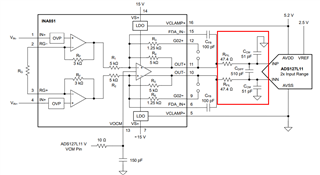Other Parts Discussed in Thread: INA851, ADS127L11, ADS127L18,
Tool/software:
Dear TI,
Can you advise please? We are using the INA851RGT fully differential instrumentation amplifier (INAMP) to drive the ADS1278MPAPTEP Differential ADC.
We are adding lowpass filtering to the INAMP to reduce the maximum output frequency into the ADC, in order to satisfy the Nyquist criteron. Our desired ADC Sampling Rate is 9 kSps, so our lowpass filter break frequency is 4.5 kHz.
We are adding two sets of lowpass filters (LPF) on the INAMP for our prototype board with the intention of removing one to see the effect after we receive hardware.
For the first LPF in the feedback loop of the INAMP, using the internal INAMP Rf = 5 kOhm, we have calculated a Cf = 7.1 nF. Please confirm I am understanding correctly how to calculate filter values in the feedback loop of this INAMP?
For the second LPF at the output of the INAMP, we have used the TI Analog Engineer's Calculator software, Ver. 1.71 (Drive Wideband Delta-Sigma ADC page) to choose a Modulation frequency = 6.75MHz, Cfilt = 2nF, which yields an Rfilt/2 = 569 ohms.
I noticed on this thread you are recommending Rfilt/2 = 50 ohms, and Cfilt = 2.2nF. I want to make sure I am considering all the design constraints of the INAMP and the ADC. Did I calculate this Cfllt value incorrectly?
Thank you.



